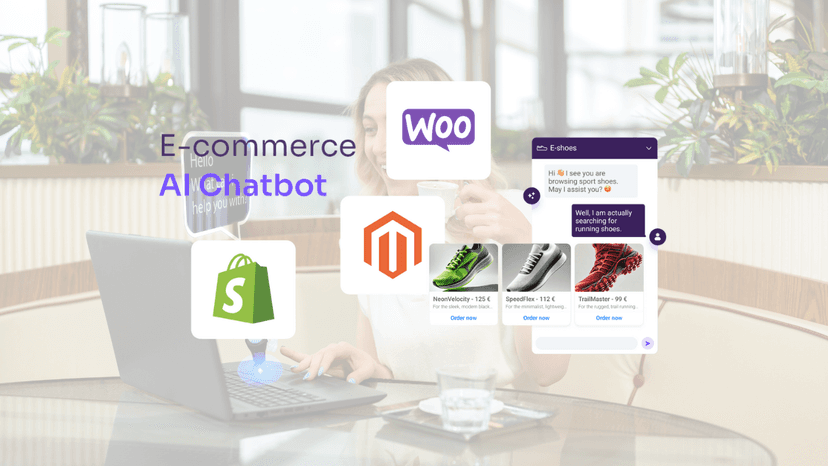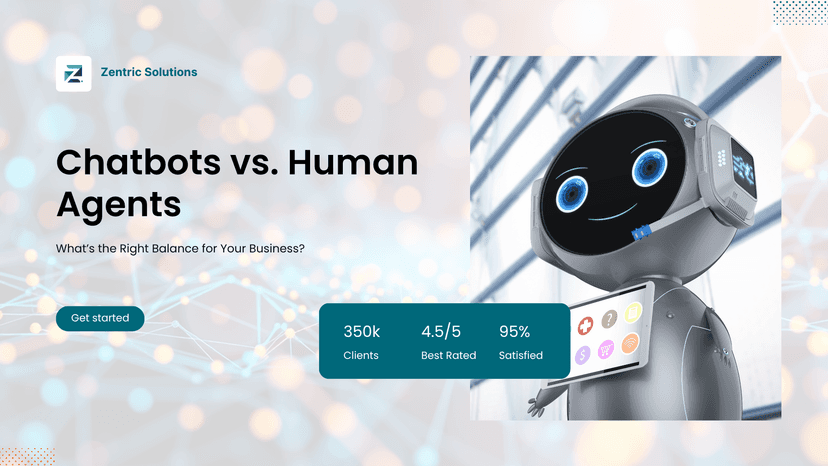
Introduction to AI Chatbots and Website Conversions
Businesses are always looking for new methods to convert website visitors into paying customers in the rapidly changing digital market. Although increasing traffic is important, conversions are the most important indicator of a website's actual performance. When a visitor completes a desired activity, such as purchasing something, subscribing to a newsletter, scheduling a consultation, or downloading a resource, this is known as a conversion.
However, because visitors frequently go without interacting, the majority of websites have high bounce rates and low conversion rates. Chatbots with AI capabilities have become a revolutionary solution in this regard. Conversion uplift of up to 35% are achieved by these intelligent assistants, which instantly engage visitors, provide personalized experiences, and assist users through the sales funnel.
This blog will examine how AI chatbots increase website conversions, provide real-world case studies, best practices for deployment, and key frequently asked questions to assist companies in utilizing this potent technology.

Understanding Website Conversions
Any activity that achieves a particular objective for your company is referred to as a website conversion. This could result in a product purchase for e-commerce websites. For service providers, this can mean asking for a quote or setting up a consultation. Websites that generate leads frequently consider downloaded resources or newsletter subscriptions as conversions.
The percentage of all visitors who finish these tasks is known as the conversion rate. Enhancing your conversion rate is essential because it reduces your need on expensive traffic-generation techniques or paid advertising by optimizing the earning potential of your current traffic.
Because they are unsure, confused, or do not receive prompt assistance, many people depart without converting. By communicating with users in real-time, responding to their inquiries, and encouraging them to take action, AI chatbots bridge this gap and boost conversions.
Why AI Chatbots Are Game-Changers for Conversions
AI chatbots are a great addition to contemporary websites because they offer a special blend of automation and customisation. Let's examine the reasons why companies are using them more and more:
1. Constant Communication with Customers
The majority of firms are unable to pay for round-the-clock human support representatives. When someone visits your website outside of regular business hours, they may have a question and decide not to convert. AI chatbots solve this issue by being available around-the-clock, managing several queries at once, and making sure no possible lead is overlooked. This continuous availability increases possibilities and lowers bounce rates.
2. Customized User Interfaces
Customers of today need tailored experiences from the brands they deal with. AI chatbots make personalized recommendations and offers based on user behavior and previous encounters. For example, returning customers may be given a special price on things they have already viewed, while first-time visitors may receive a product guide. This customization fosters trust and gently leads users to make a purchase.
3. Data-Informed Perspectives for Enhancement
Additionally, AI chatbots serve as data collection instruments, giving companies vital information about visitor behavior. Chatbots identify areas where the sales funnel needs to be improved by monitoring typical objections, drop-off points, and frequently asked questions. Businesses may improve UX, increase overall conversion rates, and hone their strategy with the help of these insights.

How AI Chatbots Increase Conversions on Websites
AI chatbots have a discernible and quantifiable effect on conversion rates. Chatbot integration on websites frequently results in more completed activities, increased engagement rates, and quicker lead response times. This is how they accomplish it:
1. Quick Answers to Inquiries from Visitors
Users are more likely to leave a website if they must wait for email responses or if live chat is delayed. AI chatbots offer prompt, precise responses to often requested queries, which keeps users interested and raises the possibility that they will make a purchase or register.
2. Helping Customers Navigate the Sales Funnel
Many visitors may be intimidated by the abundance of options or explore without any clear intention of making a purchase. As virtual sales assistants, AI chatbots determine the user's needs and walk them through the sales funnel step-by-step. Users are guaranteed to know exactly how to do their next action thanks to this proactive engagement, which also eliminates friction.
3. Cutting Down on Cart Abandonment
Cart abandonment, where customers add items then depart without making a purchase, is a common problem for e-commerce sites. AI chatbots greatly increase checkout completion rates by proactively engaging these users with reminders, time-sensitive discounts, shipping policy clarification, and last-minute questions.

Real-Life Case Studies Showing 35% Conversion Growth
Let's examine actual cases of companies that saw notable increases in conversion rates in order to grasp the full potential of AI chatbots:
1. Fashion Retailer via Online
An AI chatbot was implemented by a mid-sized online fashion retailer to provide customers with style suggestions, product availability, and sizing recommendations. The business had a 22% decrease in cart abandonment and a 35% increase in completed purchases in just three months.
- A Software as a Service Provider with Free Trials
A chatbot was installed on a SaaS company's website to respond to frequently asked questions and direct users to sign up for free trials. The business saw a 30% boost in trial sign-ups by providing proactive assistance throughout the decision-making phase, which led to a significant rise in paid conversions during the following quarter.
3. A business that provides services (healthcare clinic)
An AI chatbot was used by a nearby healthcare facility to manage appointment scheduling and service-related FAQs. Online appointment scheduling has increased by 35%, according to the clinic, which has improved patient satisfaction overall and lessened the strain for the reception staff.
These illustrations show how well-executed chatbots can convert inactive website users into paying clients, which has a direct effect on a company's financial results.

Best Practices for Implementing AI Chatbots Effectively
Businesses must carefully deploy AI chatbots in order to realize their full conversion potential. For optimum effect, follow these best practices:
1. Establish Specific Goals
Decide if the main objective of your chatbot is to recover abandoned carts, improve sales, decrease support tickets, or generate leads.
2. Select the Proper Chatbot Software
To increase productivity, pick a dependable platform with capabilities like statistics tracking, CRM integration, and NLP (natural language processing).
3. Strategically Create Conversational Flows
Make user-friendly dialogues that, without coming across as robotic, answer frequently asked questions, direct visitors, and motivate particular behaviors.
4. Use incentives and personalization
To increase conversions, use dynamic data to deliver timely discounts, special offers, or tailored recommendations.
5. Track, Examine, and Enhance Performance
Monitor chatbot data such as conversion impact, drop-offs, and engagement rate continuously. To improve the bot's performance, use insights.

Frequently Asked Questions (FAQs)
1. Can website conversions be increased by AI chatbots?
Yes, by offering immediate assistance, directing customers, and customizing their experience, AI chatbots have been demonstrated to increase website conversions by up to 35%.
2. Can small firms use AI chatbots?
Of course. Automated lead generation and round-the-clock support can help small businesses save time and increase return on investment without requiring a sizable support staff.
3. What is the price of putting an AI chatbot into place?
Prices differ based on platform and functionality. Enterprise-grade bots may be more expensive than entry-level options, which might range from $50 to $200 per month.
4. Will human customer service be replaced by chatbots?
No, chatbots assist human assistance by answering common questions and interacting with leads, freeing up human agents to work on more intricate or valuable exchanges.
5. How long does it take for a chatbot to produce results?
With the right optimization, most organizations experience measurable increases in engagement and conversions in as little as one to three months.
6. What performance indicators for chatbots should I monitor?
Engagement rate, conversation completion rate, lead generation, cart recovery rate, and total conversion lift are important KPIs.
Why AI Chatbots Are Essential for Modern Websites?
AI chatbots have been shown to increase website conversions, thus they are no longer merely a sci-fi idea. They decrease abandonment rates, remove friction from the customer experience, and convert inactive visitors into devoted patrons by offering real-time, tailored, and data-driven interactions.
Real-world examples from the SaaS, e-commerce, and service sectors show that with the correct chatbot strategy, companies can increase conversions by up to 35%. Establishing specific goals, selecting the appropriate platform, and consistently improving performance allow businesses to open up a potent new revenue stream without having to raise their visitor acquisition expenses.
AI chatbots are now a necessity for long-term company growth in a digital environment where attention spans are short and competition is intense.





